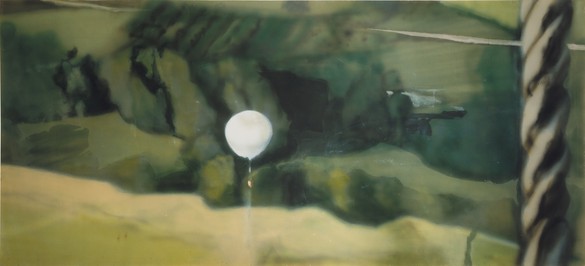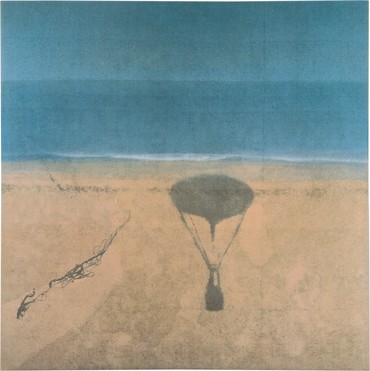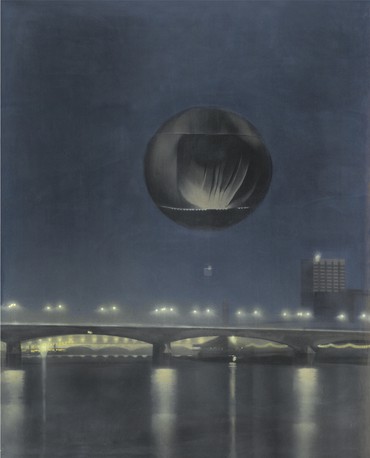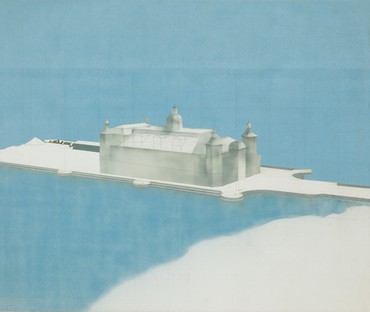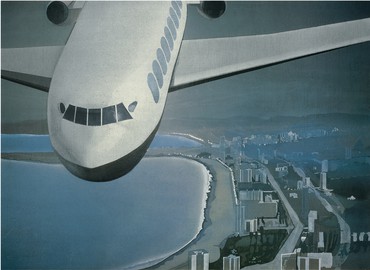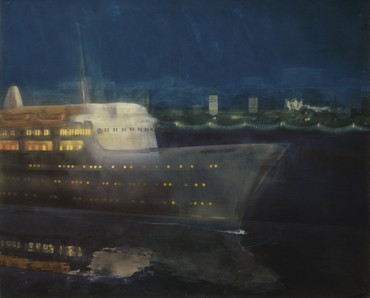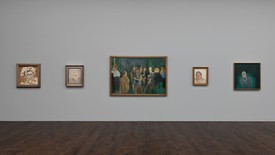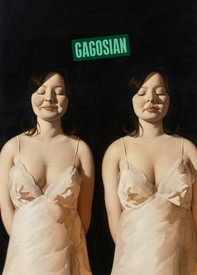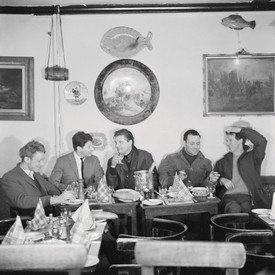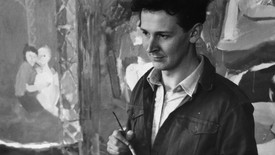
Richard Calvocoressi is a scholar and art historian. He has served as a curator at the Tate, London, director of the Scottish National Gallery of Modern Art, Edinburgh, and director of the Henry Moore Foundation. He joined Gagosian in 2015. Calvocoressi’s Georg Baselitz was published by Thames and Hudson in May 2021.
“Andrews began by making himself extraordinarily good at the outward-looking painterly skills,” wrote Lawrence Gowing in a preview of the artist’s retrospective at the Hayward Gallery, London, in 1980. “Following the whole story through the galleries one gathers the resourcefulness and compulsion with which he turned to look inward as well. The visual quality and mastery remain, rendered mysteriously airborne or liquid by turns.”1
Andrews’s “party” pictures were followed by an ambitious narrative cycle of seven paintings that occupied him for five years. It was both inward-looking and airborne, and to a certain extent liquid too. Having exhausted the subject of social interaction, Andrews turned his attention from group dynamics to individual behavior.
Some of the heads Andrews painted in 1967–69 were conceived as studies for a final party picture in which the players, or “luminaries,” would attain a state of unself-consciousness. The painting never materialized but the Lights series, as it came to be titled, was already forming in the artist’s mind. It depicts a gas balloon floating over a sequence of landscapes, from the country to the sea, via the big city with its broad river. In Andrews’s mind the balloon was a metaphor for the self as it dispenses with the ego, gradually attaining spiritual enlightenment in the process. The balloon is thus present in the first three paintings in the cycle but absent from the next three. In the seventh and last painting only its shadow is represented, emptying itself of air and coming to rest on the seashore: “I found a photograph of an aerostat, a manned balloon floating over Gloucestershire, and that together with the phrase ‘the skin-encapsulated ego’ seemed to me to make a perfect image. So out of that came a series called Lights. They were to do with sloughing off the ego.”2
Andrews came across the concept of the ego encased in a layer of skin in his reading of Alan W. Watts, the interpreter of Zen Buddhist thought. For each stage of the progress from burdensome self-consciousness to illumination and ego loss—what Andrews called “flight and the evolving experience”—he had to invent convincing pictorial equivalents. From a folder of found images in his archive, marked “Landings & Landing Places & The Full Inner Experience, i.e. good or bad enlightenment, illusion or disillusion,”3 it appears that he attached particular importance to the spot where the balloon would drop to earth:
I imagined my series ending in an idyllic place. The Pier Pavilion [Lights V] was one of the pictures that represented an idyllic place. The Pier and the Road [Lights IV], which preceded it, was a search for such a place . . . . In the event I never painted these enlightened souls coming to land anywhere, but The Pier Pavilion was a … sort of stately pleasure dome in a kind of idyllic Xanadu that the balloon, the ego, passes over.4
Images of space travel and weightlessness, of sights never before observed by human beings, apparently stimulated Andrews’s interest in flight generally and in seeing the world from the air.
Richard Calvocoressi
Lights I: Out of Doors, which Andrews began in 1969, was the first painting in which he used a spray gun and acrylic paint. His initial reasons were, he said, romantic: “I wanted the balloon to be floating through an airy space and I thought, I’ll use a spray gun, I’ll blow the paint on, that’s airy.”5 Sprayed onto unprimed canvas, the water-based acrylic stained the surface of the canvas and was then absorbed by it, causing the flock to push up and creating “a kind of atmospheric veil between you and the object.”6 It had other advantages, Andrews found, such as speed of application and drying, especially useful when covering very large areas, though it was not without its own dangers.
While working on the final painting in the cycle, Lights VII: A Shadow (1974), Andrews attended an international balloon meeting at Cirencester Park in Gloucestershire. There he would have observed gas and hot-air balloons taking off, free-fall parachute and skydiver demonstrations, as well as balloon-inflation demonstrations.7 Whether any of this influenced the development of A Shadow is difficult to say. Provisionally entitling the work The Artificial Horizon, Andrews described it as “an almost empty canvas with balloon coming in against an empty shore,”8 and considered it one of his best paintings: “It embodied the extent of my success and failure to come to terms with myself, by which I meant I was less egotistical than when I started the Lights series but not unegotistical or without ego as I would like to be.”9 Whatever its merits as personal therapy, it is a sublime, almost abstract image. Remove the hazy imprint of the descending balloon and the straggle of seaweed on the beach and you are left with almost nothing: three horizontal bands of color corresponding to sky, sea, and sand—a vision of infinity worthy of Rimbaud’s Les Illuminations, the prose poem that inspired the whole series.
In contrast, Liner (1971–72) and Cabin (1975) can be read as vehicles-cum-containers, either for the crowd, the masses—the opposite of Andrews’s “enlightened souls”—or for the “luminaries” themselves. Cabin was originally to have included faces at the windows, based on photographs of miners underground.
“Liner” and “Cabin” can be read as vehicles for Andrews’s “enlightened souls.” “Cabin” was originally to have included faces at the windows, based on photographs of miners underground.
Richard Calvocoressi
Andrews’s fascination with the world’s wonders cannot be explained by simple wanderlust. Deeper preoccupations prevailed. One of the largest groups of material in his archive concerns scientific discovery. In the 1960s Andrews subscribed to the weekly magazine New Scientist and owned a copy of the Larousse Encyclopedia of Astronomy, both of which he plundered for images and ideas. From the latter he cut out illustrations of stars, shooting stars, constellations, Saturn and other planets, extragalactic nebulae, galactic magnetic fields and globules, eclipses, comets: in short, a wide range of celestial objects—understandable interests, perhaps, in an abstract artist but esoteric for a representational painter like Andrews. New Scientist provided him with information on the latest technological inventions as well as discussion of ethical issues such as advances in biological medicine, radiation, pollution, and political control. Featured subjects that caught his eye, especially if they were illustrated with striking colored diagrams, include (in no particular order) electrical fields, the behavior of particles, fluidized reactors, earthquakes, the control of plant growth, artificial plasma clouds, rotation and powder photographs, X-ray analysis, electron micrographs, ultraviolet radiation, computerized heat exchangers, electronic systems in the defense industry, holography, planetary radar astronomy, light projection, the science of illusion, molecular biology, cancer cells, sound, noise pollution, boomerangs in flight, crystals, telescopes, and light boxes. He also showed an interest in new materials—molded plastics, Perspex, new types of glass, strengthened steel.
Here, clearly, was an inquiring mind, someone eager to understand what the universe and the physical world—energy, matter, the cosmos—looked like and how they worked. He once admitted to an “obsessive compulsion to know (vividly realize) the inner structure of any phenomenon that happens to puzzle me,” calling it a “neurosis.”10 Hardly surprising, then, to find Andrews captivated by the sublime images resulting from the exploration of outer space that accelerated in the second half of the 1960s with the various Apollo missions from the United States. These culminated in the first manned space flight to orbit the moon, in 1968, and the first moon landing, in the summer of 1969, producing a wealth of film stills and photographs that Andrews duly collected. In July and August 1969 the Sunday Times Magazine, Britain’s first weekly color supplement (launched in 1962), devoted three successive issues to the recent moon landing, documenting the historic journey “from blastoff to splashdown” and publishing “the first color pictures ever taken by men on the surface of the Moon.” Andrews’s copies of the magazine survive in the Tate Archive, along with illustrations torn from other publications showing the predominantly blue earth floating in an inky black void 240,000 miles (385,000 kilometers) away from the astronauts and shots of the capsule parachuting into the sea.
Images of space travel and weightlessness, of sights never before observed by human beings, apparently stimulated Andrews’s interest in flight generally and in seeing the world from the air. He accumulated dramatic photographs of jets and fighter planes, skydivers, parachutists viewed from above and below, clouds seen from 30,000 ft (9,000 meters), as well as aerial views of landscapes and cities—especially high-rise buildings at night—which he gathered together in a folder marked “Places flown over.” He began to prefer panoramic or high viewpoints for his own paintings and twice took photographs of his motifs from the air: the first time in Australia, from a light aircraft flying over Ayers Rock and the Olgas at sunset, the second from a helicopter hovering over England’s Vale of Pewsey while researching his landscape Oare, the Vale of Pewsey (1989–91). On a scrap of paper on which Andrews was trying out possible titles for the Lights series he wrote, “Up is a nice place to be”—the title of a 1967 American folk song—and added the words “the best.”11 There is no evidence that he was familiar with the theories of the French philosopher Gaston Bachelard, but the latter’s concept of “ascensional psychology,” with its analysis of aerial imagery, dreams of flight, the association of air with mobility
and freedom, and the wish to escape the earth’s atmosphere, seems remarkably relevant to his preoccupations.12
1Lawrence Gowing, “Painter of Fact and Feeling,” Sunday Times Magazine (London), October 26, 1980, p. 112.
2Michael Andrews, in an interview with Anna Benson Gyles, April 1990, unedited transcript of BBC TV Omnibus film, As It Seems: A Profile of Michael Andrews, broadcast January 1991, 1/LMA S643K, S.R. 2/5.
3Tate Archive, TGA 2000/25, MA 23.
4Andrews, in the interview with Gyles, S.R. 3/3.
5Ibid., S.R. 4/8.
6Ibid., S.R. 4/9.
7Daily Express International Balloon Meeting, Cirencester Park, June 15–16, 1974. There is an annotated program in the Tate Archive, TGA 2000/25, MA 22.
8Tate Archive, TGA 2000/25, MA 25.
9Andrews notes, July 1980, in author’s possession.
10Andrews notes, January 1974.
11Tate Archive, TGA 2000/25, MA 22.
12See Gaston Bachelard, Air and Dreams: An Essay on the Imagination of Movement, 1943, Eng. trans. Edith R. Farrell and C. Frederick Farrell (Dallas: The Dallas Institute Publications, 1988).
Artwork © The Estate of Michael Andrews
